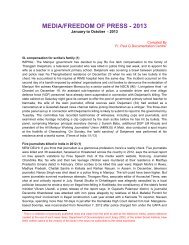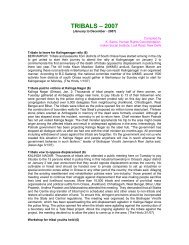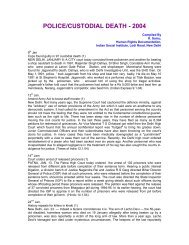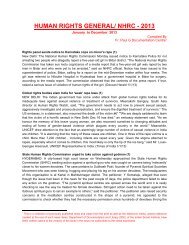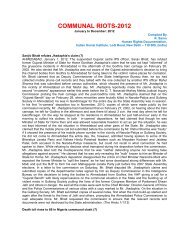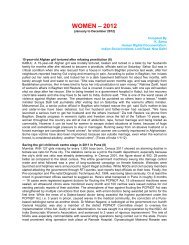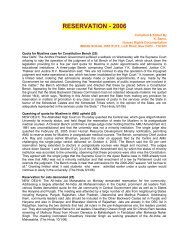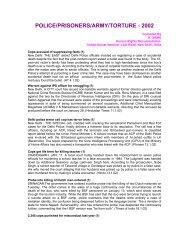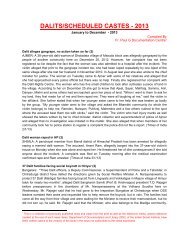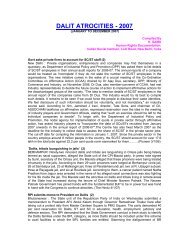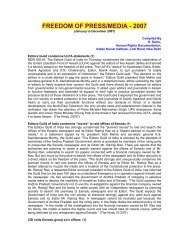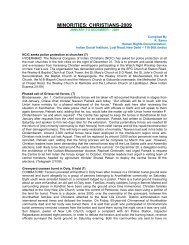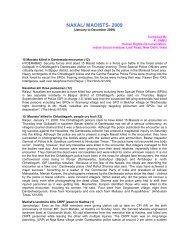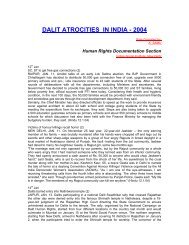WOMEN â 2011 - Indian Social Institute
WOMEN â 2011 - Indian Social Institute
WOMEN â 2011 - Indian Social Institute
You also want an ePaper? Increase the reach of your titles
YUMPU automatically turns print PDFs into web optimized ePapers that Google loves.
Women, formally known as the United Nations Entity for Gender Equality and the Empowerment of<br />
Women, is the United Nations' most ambitious effort ever to accelerate actions to achieve gender<br />
equality. Website launched Meanwhile, Partners for Law in Development (PLD) also launch the CEDAW<br />
[Committee on the Elimination of Discrimination Against Women] South Asia website. This site has been<br />
developed as a comprehensive resource for the South Asia region to facilitate regional sharing and to<br />
strengthen implementation of CEDAW. The web resources have been produced by PLD with support<br />
from UN Women to enable easy access to CEDAW related material. The website offers user-friendly<br />
layout and gives basic yet comprehensive information. The content is layered, providing basic information<br />
on CEDAW with the option of sourcing more detailed information. One can find country specific<br />
information viz. ratification and reporting status of the countries in South Asia, the initial and periodic<br />
reports, concluding observations, and theme-based information on the website. Information regarding<br />
training events and announcements on women's rights in these countries, the region and beyond will also<br />
be available from the site. LD is a legal resource group working in the fields of social justice and women's<br />
rights in India that has contributed significantly in creating resources, providing capacity building and<br />
advocacy on CEDAW in South Asia. (Hindu, 09/03/<strong>2011</strong>)<br />
43% of underage married girls suffer marital violence: Survey<br />
When Delhi-based researcher Shruti Chaudhry visited a village in Badaun district of Uttar Pradesh to<br />
study migration, she stumbled upon two darker secrets of India's family life. Talking to women in Chabutra<br />
village, she learned that most women got married when they were 14 to 16 years old. But that was not all.<br />
"A husband of one of the women we talked to later told us that his wife had given wrong information,<br />
which he wanted corrected. He added that he had soundly thrashed her for this," said a troubled Shruti.<br />
Adolescent marriage and domestic violence are two widely prevalent but unacknowledged practices.<br />
Recent studies on the married life of adolescent girls reveal a chilling link between the two. Anita Raj of<br />
Boston University School of Public Health, involved in several such studies said that adolescent marriage<br />
appears to be directly correlated with increased violence at home: emotional, physical and sexual,<br />
practiced both by the husband and the in-laws. It is unabated even during pregnancy and motherhood.<br />
And, most sobering of all, female children born to under-age mothers suffer from higher risks of dying<br />
before they reach their fifth birthday. Raj led a study, published in the International Journal of Gynecology<br />
and Obstetrics, of over 10,000 married women aged 20 to 24 years which showed that 43% of under-age<br />
married women said they had been subject to marital violence, while 24% of adult-married women<br />
reported such events. Severe, life-threatening violence was experienced by 16% of under-age married<br />
women compared to 6% of adult married women. In another study of young mothers from a low-income<br />
locality in Mumbai, Raj found that physical and non-physical abuse by husbands and in-laws continued<br />
during pregnancy and while nursing new-borns. "I get up at 3 or 4 a.m. to get water. After that, I make<br />
breakfast and prepare a lunch box for my father-in-law and sister-in-law. I make a separate lunch for my<br />
mother-in-law, wash clothes and clean the house. I had to do my work whether I was pregnant or not. No<br />
one helped me," said a 16-year-old mother quoted in Raj's study. The study documents hair-raising<br />
accounts of denial of food and healthcare, beatings, forced drudgery, by the marital household. It showed<br />
that violence by other family members was more likely when husbands were violent towards the wife. A<br />
study by Jay Silverman of Harvard School of Public Health, Anita Raj and others has shown that underage<br />
marriage led to higher infant and child mortality rates of daughters and not sons compared to women<br />
who were married in adulthood. Another study of married women in five <strong>Indian</strong> states by Delhi's<br />
Population Council and Mumbai's International <strong>Institute</strong> of Population Studies showed that under-age<br />
married women got less autonomy and were less likely to express opinions on domestic issues.<br />
Importantly, under-age mothers were significantly less likely to have had their first delivery in a health<br />
facility. Although the proportion of girls married off in the 15 to 19 year age group has declined from 56%<br />
in 1971 to about 27% in 2006, it still means that over 1.5 crore girls are thus married. And, 16% of the age<br />
group, that is about 2.4 lakh women had already become mothers or were pregnant, according to the<br />
National Family & Health Survey-3. Raj says that these issues are compromising the health and<br />
development of the country as a whole. But she is optimistic. "Fortunately recent movements in public<br />
health in the country have recognized these issues as needing to be addressed," she says. (TOI,<br />
09/03/<strong>2011</strong>)<br />
In-laws were harassing Nidhi, father tells police<br />
MUMBAI: A day after chartered accountant Nidhi Gupta flung her two children off the 19th storey of her



